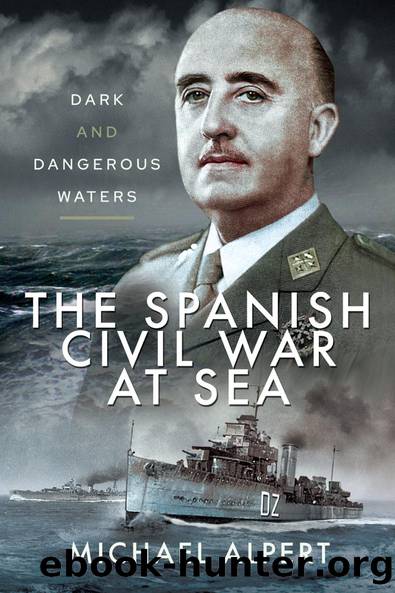The Spanish Civil War at Sea by Michael Alpert

Author:Michael Alpert [Alpert, Michael]
Language: eng
Format: epub
Tags: History, Military, Wars & Conflicts (Other), Europe, Spain & Portugal, Modern, 20th Century, Naval
ISBN: 9781526764379
Google: gQc8EAAAQBAJ
Publisher: Pen and Sword Maritime
Published: 2021-10-31T01:06:03+00:00
V Insurgent Succcesses in Spring 1937
Once again, the Republican chain of command and authority seems to have been weak and uncertain. Who decided the strategy to follow? Was it the Minister, Prieto, properly advised by a chief of staff and obeyed by the fleet commander? Obscure Soviet manipulations may not always have been responsible, but nevertheless the essential task of protecting transports coming from the USSR was paramount.
Sometimes the Insurgents also made errors. Their level of information was not always equal to their skill and determination. A Republican freighter, the Marqués de Comillas, was being watched at Odessa and as it sailed through the Bosphorus, agents alleged that it was carrying sixty artillery pieces, thirty-five tanks, fifty lorries, fifteen hundred tons of other items and one thousand tons of foodstuffs. The Insurgent fleet set up a barrier along the Spanish coast with the cruisers and a number of armed merchant vessels.The Marqués de Comillas was stopped on 28 January fifteen miles off the coast.31 When it was searched, its sole cargo was cotton. Probably, the Russians had set up a skilful deceit in order to draw the Insurgent warships away from a vessel carrying military items.
However, a few weeks later the Insurgents triumphed when they captured the Mar Cantábrico. This vessel carried aircraft and other war material worth US $2,775,000 which had been bought from the Vimalert corporation of New Jersey, whose president, Robert Cuse, acted as an agent for the Soviet trading entity Amtorg. The aircraft were part of a major deal in the United States, which had maintained a âmoral embargoâ since 11 August 1936 against selling arms to either side in the Spanish war. Unscrupulous dealers could ignore it. As the aircraft were being dismantled to be stowed in the hold of the ship, President Roosevelt asked Congress to extend the Neutrality Act of 1935 to civil wars. On 6 January 1937 two senators presented bills which would make sales of arms to Spain illegal. The ban would begin on January 8. The stevedores managed to load eleven aircraft on the Mar Cantábrico, according to the information reported by The Times on 6 January. The ship would not, however, complete its journey to Republican Spain.32 Having called at Vera Cruz to pick up some more war material, the Mar Cantábrico sailed at 0600 hours on 19 February. Its course and the date and port of arrival ought to have been kept rigorously secret. Nevertheless, Prieto told Aguirre, the Basque President, that arrival was expected at Santander on 5 or 6 March, and revealed the signal codes and details of the cargo.33
The Insurgents were alerted first by the publicity given to the loading and departure of the Mar Cantábrico from New York. They would have been aware of the official messages, sent with little concern for security, and possibly by information from the Republican destroyer José Luis DÃez, whose officers deserted in Bordeaux where it had anchored in flight from the Canarias.34 On 8 March, the Canarias stopped
Download
This site does not store any files on its server. We only index and link to content provided by other sites. Please contact the content providers to delete copyright contents if any and email us, we'll remove relevant links or contents immediately.
Room 212 by Kate Stewart(5077)
The Crown by Robert Lacey(4768)
Endurance: Shackleton's Incredible Voyage by Alfred Lansing(4725)
The Iron Duke by The Iron Duke(4325)
The Rape of Nanking by Iris Chang(4173)
Joan of Arc by Mary Gordon(4058)
Killing England by Bill O'Reilly(3974)
Say Nothing by Patrick Radden Keefe(3940)
I'll Give You the Sun by Jandy Nelson(3400)
Shadow of Night by Deborah Harkness(3327)
Hitler's Monsters by Eric Kurlander(3294)
Mary, Queen of Scots, and the Murder of Lord Darnley by Alison Weir(3177)
Blood and Sand by Alex Von Tunzelmann(3170)
Eleanor & Park by Rainbow Rowell(3120)
Darkest Hour by Anthony McCarten(3100)
Margaret Thatcher: The Autobiography by Thatcher Margaret(3053)
Book of Life by Deborah Harkness(2895)
Red Famine: Stalin's War on Ukraine by Anne Applebaum(2895)
The One Memory of Flora Banks by Emily Barr(2837)
